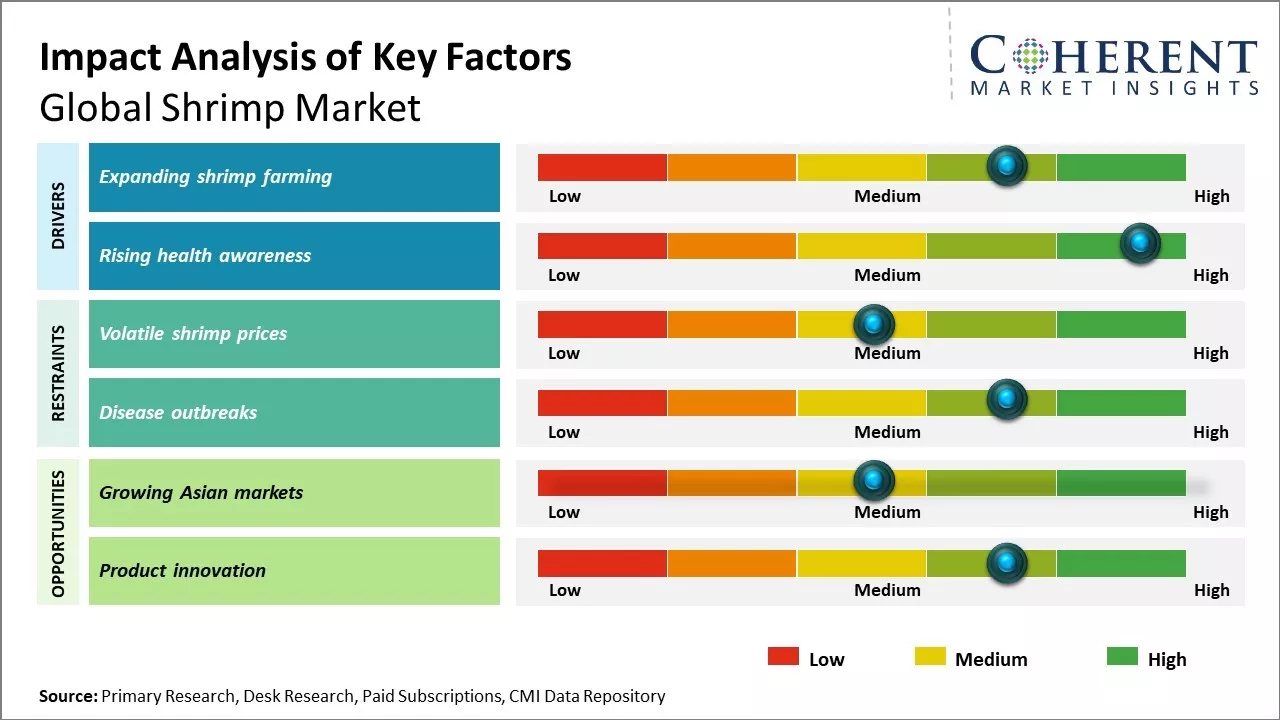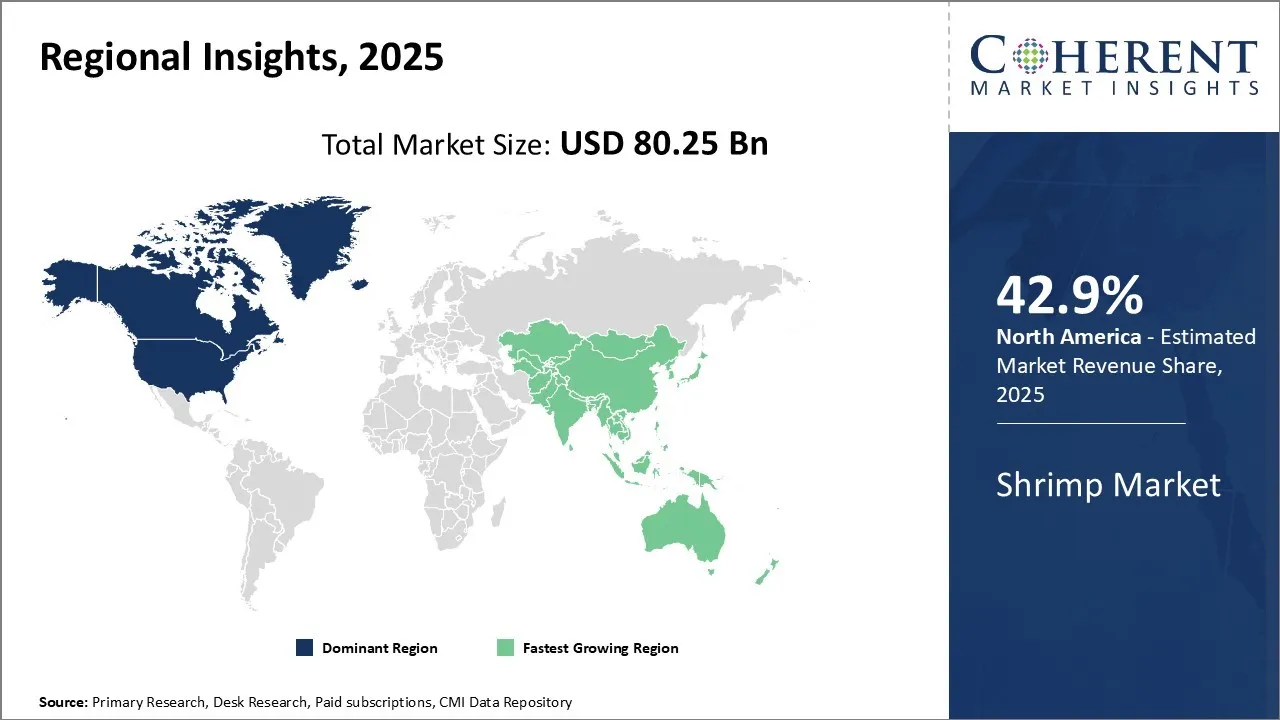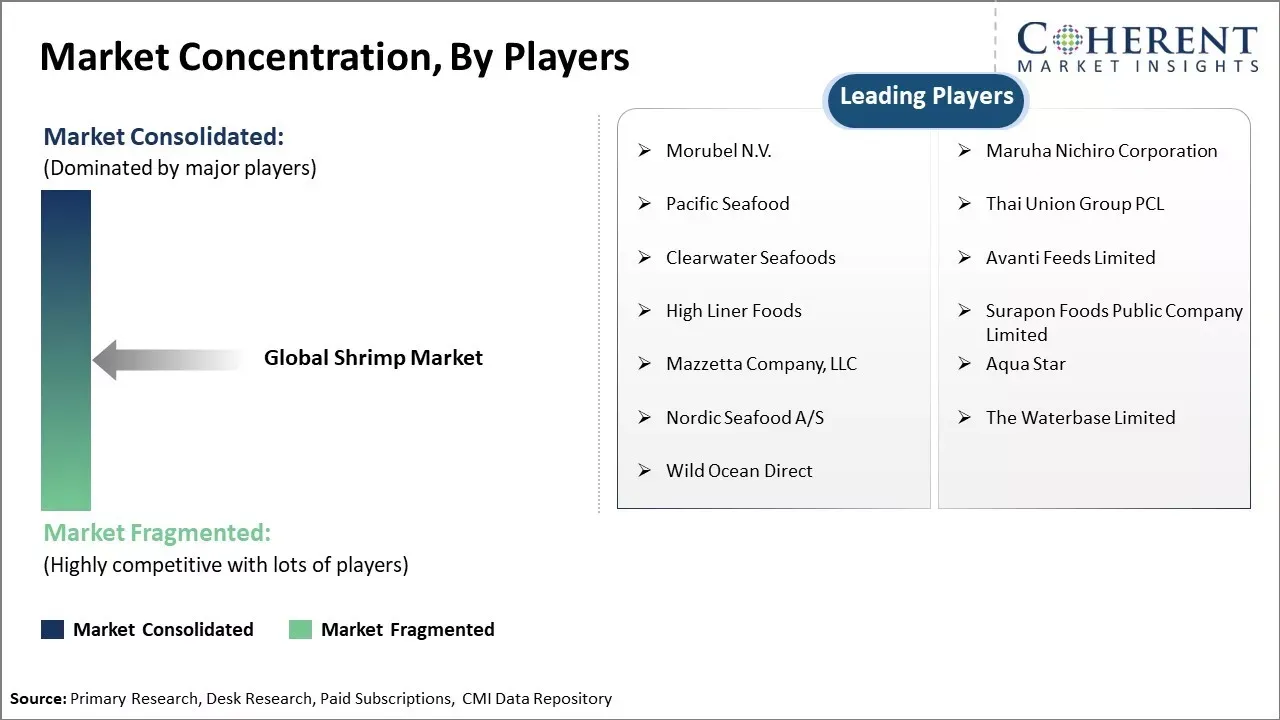The shrimp market is estimated to be valued at USD 80.25 Bn in 2025 and is expected to reach USD 117.60 Bn by 2032, exhibiting a compound annual growth rate (CAGR) of 5.6% from 2025 to 2032.

To learn more about this report, Download Free Sample
The global shrimp market has been witnessing positive growth over the past few years. The demand for shrimp is increasing globally due to its high nutritional value and various health benefits. Shrimp is a rich source of protein and contains other nutrients like vitamins and minerals. It is also low in calories, making it a preferred choice.
Moreover, increasing seafood restaurants and the online selling of shrimp products have boosted the market growth. However, environmental issues related to overharvesting and diseases affecting shrimp farming could pose a challenge to the market growth. Regulations related to sustainable shrimp farming need to be complied with carefully.
|
Current Event |
Description and its Impact |
|
Disease Outbreaks in Aquaculture |
|
|
Technological Advancements in Aquaculture |
|
Uncover macros and micros vetted on 75+ parameters: Get instant access to report
Cold water shrimps segment is expected to contribute 84.0% share of the shrimp market in terms of source type in 2025, due to their perceived health and quality advantages over other varieties. Cold water shrimp species typically inhabit cooler northern waters and are prized by health-conscious consumers for their high protein and omega-3 fatty acid content. These nutrients provide notable heart health and cognitive benefits. Research increasingly links diets rich in seafood like cold water shrimp to reduced risk of many chronic diseases.
For instance, in June 2025, the USDA purchased USD 16 million worth of Oregon's coldwater pink shrimp to help the fleet through hard times. Oregon's shrimp fishery, which is based on wild-caught coldwater species, is having trouble landing shrimp and selling them. The goal of the purchase is to stabilize the industry, which is going to assist the economy and keep businesses running in the Pacific Northwest.
Farmed Whiteleg Shrimps segment is expected to account for the 33.9% share of the shrimp market in terms of species in 2025. They are a popular choice due to a combination of availability, familiarity and culinary versatility. As the most widely farm-raised shrimp globally, Whiteleg Shrimps can be found year-round in a variety of product forms. Consumers develop trust from consistent positive experiences selecting and cooking them.
For instance, in June 2025, Agriminigold S.A. in Ecuador is the first shrimp farm in the country to join the ASC Improver Programme. The project focuses on farmed Whiteleg shrimp (Litopenaeus vannamei) and promotes sustainability, environmental responsibility, and better practices. It helps Ecuador stay at the top of the list for responsible aquaculture and global shrimp production standards.
In terms of form, frozen segment is expected to account for 37% of the market share in 2025, due to its unmatched convenience compared to other formats. Freezing preserves shrimp's freshness, flavor and nutrition for much longer than alternative preservation methods. It allows supply to exceed fleeting local seasons and satisfy year-round consumption demand. Frozen shrimp retains a reputable quality standard, reassuring time-pressed buyers.
For instance, in February 2025, SeaPak and Gorton have added frozen shrimp products with Cajun and coconut flavors to their stores. These extra-value items are aimed at people who want bold flavors and convenience. The launch strengthens their position in the frozen seafood market by highlighting new products and a wide range of options to meet changing demand for shrimp in homes and restaurants.
In terms of end use industry, the food segment is expected to lead the market with largest share in 2025, driven by global demand for frozen, canned, and value-added products. Its high protein and low-fat profile make it a preferred seafood choice. Restaurants, retail, and home cooking fuel consumption, ensuring food remains the largest and most influential shrimp market segment worldwide.
For instance, in December 2025, Handy Seafood has launched a new global appetizer called Shrimp Birds Nests, which has shrimp as the main ingredient. The product is meant to appeal to both the food service and retail markets. It combines new ideas, taste, and ease of use. This launch adds to Handy's value-added shrimp line, giving people all over the world a unique seafood experience they have to try.
In terms of distribution channel, the Hypermarket/Supermarket segment is expected to hold the highest share of the market in 2025, offering frozen, fresh, and value-added products to mass consumers. Their wide reach, competitive pricing, and convenience make them the leading channel. Certifications and sustainability labels also influence purchases, reinforcing supermarkets as the primary driver of shrimp retail sales globally.
For instance, in February 2025, SeaPak unveiled Classic Cajun Style Shrimp, a frozen meal that is ready to cook and tastes like New Orleans food. It has a strong flavor and is easy to use as it is seasoned with cayenne, garlic, black pepper, and real butter. It goes well with rice, grits, or bread, making shrimp more appealing to eat. It was made for retail and food service.

To learn more about this report, Download Free Sample
North America has long been the dominant region in the global shrimp market. The region is expected to account for 42.9% of the market share in 2025, particularly led by the U.S. The large population and high seafood consumption have supported strong and steady demand in the region for decades. The frozen shrimp segment dominates sales, with various processing facilities distributing products nationwide to major grocery retailers and restaurants. A developed aquaculture industry has also supplemented robust wild catches to maintain supply. While much of the shrimp supply has traditionally been imported, strong domestic aquaculture production in countries like Mexico and Ecuador in recent years have increased their share exported to North America.
For instance, in July 2025, Prime Shrimp, which is based in Louisiana, USA, released a new shrimp burger for both direct-to-consumer and foodservice markets. This product adds new types of shrimp to the menu, showing how value-added innovation can improve things. The launch makes Prime Shrimp a greater force in the U.S. seafood industry and gives customers more options and convenience across the country.
A fast-rising force has emerged in Asia Pacific has experienced exponential shrimp market growth over the past 10 years. Led by Thailand and Indonesia, several Southeast Asian countries have aggressively expanded shrimp farming. Their climatic conditions are extremely well-suited for producing large shrimp crops year-round. Asia Pacific has increasingly become a key shrimp supplier and processing hub not only for neighboring Asian markets but also exports further abroad. More multinationals in the seafood industry have also established shrimp processing facilities in ASEAN to leverage its lower production costs and tap growing intra-Asian trade flows.
For instance, in November 2025, the FAO helped Sri Lanka start its first digital shrimp platform, which is meant to bring aquaculture up to date. This program makes shrimp farmers' work more efficient, sustainable, and easier to get to markets. Sri Lanka's shrimp industry gets stronger by using technology. This encourages new ideas and responsible practices, which makes the industry more competitive in global seafood markets.
In 2025, U.S. shrimp demand is rising due to strong consumer preference for seafood, growth in value-added products, and expanding foodservice channels. Sustainable farming and processing innovations boost supply, while imports from Ecuador, India, and Vietnam meet demand. Shrimp remains America’s most consumed seafood, driving steady market growth.
For instance, in April 2025, using recirculating aquaculture technology, Atarraya has opened a new RAS shrimp farm in New Jersey, USA. The facility's main goal is to farm Whiteleg shrimp (Litopenaeus vannamei) in a way that is good for the environment. This new idea boosts shrimp farming in the U.S. by encouraging responsible aquaculture and increasing the domestic supply through eco-friendly, land-based farming methods.
South Korea’s shrimp market demand in 2025 is driven by rising seafood consumption, health-conscious consumers, and aquaculture innovations. Shrimp’s high protein and low fat appeal boosts popularity, while government support and sustainable farming investments strengthen domestic supply.
For instance, in December 2025, Hongkong Banjum in South Korea has launched a limited shrimp Toowoomba Jjamppong, a Korean-Chinese noodle dish featuring shrimp as the star ingredient. This special edition highlights bold flavors and seafood innovation, offering consumers a unique culinary experience while expanding the chain’s menu with a creative, shrimp-focused seasonal offering.
| Report Coverage | Details | ||
|---|---|---|---|
| Base Year: | 2024 | Market Size in 2025: | USD 80.25 Bn |
| Historical Data for: | 2020 To 2024 | Forecast Period: | 2025 To 2032 |
| Forecast Period 2025 to 2032 CAGR: | 5.6% | 2032 Value Projection: | USD 117.60 Bn |
| Geographies covered: |
|
||
| Segments covered: |
|
||
| Companies covered: |
Morubel N.V., Maruha Nichiro Corporation, Pacific Seafood, Thai Union Group PCL, Clearwater Seafoods, Avanti Feeds Limited, High Liner Foods, Surapon Foods Public Company Limited, Mazzetta Company, LLC, Aqua Star, Nordic Seafood A/S, The Waterbase Limited, and Wild Ocean Direct |
||
| Growth Drivers: |
|
||
| Restraints & Challenges: |
|
||
Uncover macros and micros vetted on 75+ parameters: Get instant access to report
The global demand for shrimp has been steadily rising in the recent decades. As the population and income levels grow across regions, especially in developing countries in Asia Pacific and Latin America, consumers are gradually increasing their seafood consumption, with shrimp being one of the most popular choices. In order to meet this ballooning demand, shrimp farming activities around the world have expanded aggressively. Countries such as India, China, Vietnam, Indonesia, and Ecuador have emerged as major shrimp culturing nations to capitalize on the lucrative opportunities.
Shrimp farming is largely done in brackish water conditions, either in ponds along the coastal lines or in tanks with controlled salinity levels. It provides an excellent way to generate income and employment in coastal and island communities. With guidance and support from governments and international organizations, small and marginal fishermen are encouraged to take up shrimp farming as a supplementary livelihood. Large-scale commercial shrimp farms have also come up with advanced hatchery facilities and water recirculation systems to ensure year-round production. Technological improvements in areas such as breeding, feed formulation, disease control, and harvesting have steadily boosted overall yields from shrimp culture. The availability of low-cost labor in many developing markets and subsidies/tax benefits offered by some governments have further spurred multi-fold expansion of the industry.
Another important factor propelling the shrimp market growth is the increasing health consciousness among consumers globally. With growing incidents of lifestyle diseases, more people are being attentive towards maintaining a balanced diet and active lifestyle. Shrimp has emerged as a popular choice due to its high nutritional value and low fat content compared to other seafood varieties. It is rich in high-quality protein, vitamin B12, selenium, zinc, and omega-3 fatty acids. Regular consumption of shrimp is credited with various health benefits, such as reducing inflammation and lowering cholesterol, boosting brain function and minimizing risks of chronic conditions.
Awareness about these advantages along with changing preferences towards protein-rich diets have made shrimp a sought-after ingredient. Marketers highlight its health credentials through advertisements, branding, and nutrition guides. Social media further spreads knowledge on cooking various shrimp delicacies. As consumers pay more attention towards ingredient labels, product claims and food miles, farmed shrimp raised in a sustainable manner garners added interest.
The growing Asian market offers tremendous opportunities for growth in the global shrimp market. Asia's rising affluence and appetite for high-quality protein presents a massive consumer base that is ripe for shrimp consumption. Countries like China, India, and Vietnam already have strong seafood cultures and witness increasing shrimp demand annually. With economic development and westernization of diets, more Asian consumers now view shrimp as a desirable and prestigious food. Shrimp features heavily in Asian fine dining and is increasingly popular as a quick serve option as well, benefitting from its convenience and versatility.

To learn more about this report, Download Free Sample
The shrimp market is one of the most important parts of the global seafood industry for business, thanks to the growth of aquaculture on a large scale and steady international trade. It is thought that the world produces almost 6 million metric tons of shrimp, with Ecuador, China, India, Vietnam, and Indonesia together making up almost three-quarters of that. Farmed shrimp makes up more than 60% of the world's supply. This is because of improvements in breeding, feed efficiency, and intensive farming methods.
Asia Pacific white shrimp (Litopenaeus vannamei) continue to be the most commonly grown shrimp species. It makes up about 80% of all farmed shrimp due to survives well, grows quickly, and can adapt to different climates.
Processing trends show that more and more people are choosing ready-to-cook and pre-seasoned formats, which now make up a larger share of traded volumes. Traceability programs, certification standards, and export compliance requirements are also having a bigger and bigger impact on how suppliers are chosen as well as the prices are set. In general, the shrimp market is moving toward higher efficiency and value addition. Production scale, species optimization, and supply chain transparency will continue to be important for the long-term success of the industry.
Definition: "This premium shrimp product is sourced directly from small artisanal shrimp farms along the coast. The shrimp are hand-peeled daily and never frozen to ensure the highest quality. Only the largest shrimp with intact shells is selected to be quickly boiled, cooled, and packaged fresh for customers. This process allows the natural sweet flavor and firm texture of the shrimp to shine through. As a result, home cooks and professional chefs alike rely on this market's fresh shrimp to take their coastal cuisine to the next level."
Share
Share
Missing comfort of reading report in your local language? Find your preferred language :
Transform your Strategy with Exclusive Trending Reports :
Frequently Asked Questions
Joining thousands of companies around the world committed to making the Excellent Business Solutions.
View All Our Clients